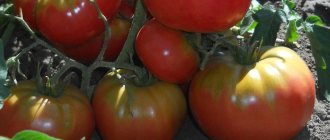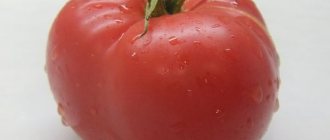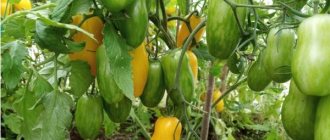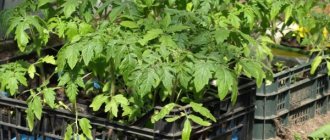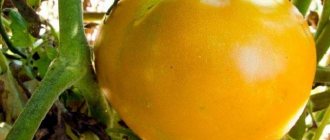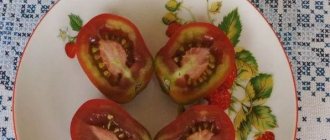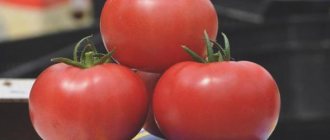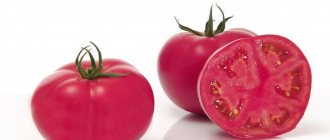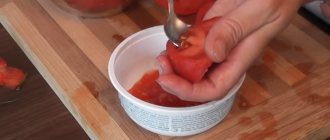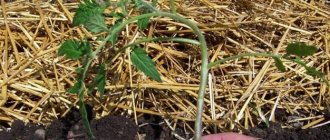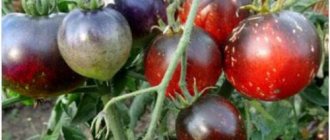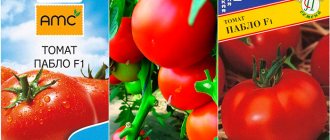When choosing tomatoes for planting, be sure to pay attention to color, shape, and weight. Large pink giants are one of the most beloved by gardeners. Among them, the right size tomato stands out with excellent taste and good productivity.
| Height | Landing location | Ripening time | Fruit color | Fruit size | Origin | Fruit shape |
| Tall | Greenhouse, Open ground | Mid-season | Pink | Large | Hybrid | Flat-round |
Description of the variety
Fruit:
- Flat-round in shape, have a small depression near the stalk and slight ribbing;
- Those that have not reached varietal ripeness are green in color with a light spot near the stalk. When ripe, it is deep red in color;
- With dense, smooth skin;
- With fleshy, sugary pulp, pleasant taste, with few seeds;
- Large sizes. The average weight varies from 300 to 500 grams; in greenhouse conditions, the weight of the fruit reaches from 700 to 900 grams.
Chinese way of growing tomatoes:
Bushes:
- Indeterminate plant, densely leafy;
- When grown in unprotected soil, it reaches 170-180 cm; in greenhouse conditions it grows more than two meters;
- The leaves are medium in size, dark green in color, shaped characteristic of tomatoes, with a loose structure, slightly corrugated;
- The inflorescence is simple.
Late ripening
It is impossible to delay the sowing of seeds of such varieties; the ripening period is delayed up to 4 months (about 130 days). If you do not have time to harvest, frost will kill it. For this reason, it is better to use a greenhouse for growing. Late-ripening tomatoes are high-growing; the plant requires time to grow stems and leaves. Among the late varieties demanded by gardeners are:
- Vladimir F1
- Date fruit
- Titanium
- Bull's heart
Think in advance for what purpose you are growing fruits.
- Tomatoes of the correct shape, with firm skin and without a tendency to crack are suitable for canning. These are Sanka, Chocolate Bullet, Lapwing and others.
- Tomatoes with a small number of seeds, large sizes, and a sweet taste are suitable for harvesting raw and freezing. This is Bull's Heart, Giant, Cardinal, Mashenka.
- For food in the summer, choose Dessert, Pink Cherry, Danko, Infiniti F1, Cherry. These fruits are soft, juicy and sweet.
- Universal varieties can be preserved and enjoyed with pleasure during the period of full ripening. This is Shchelkovsky early tomato, Alaska, Cio-chio-san.
Tomatoes: advantages and disadvantages
The “Need Size” tomato variety has a number of advantages:
- Excellent taste characteristics;
- Large fruit;
- Good safety during transportation;
- Commercial appearance of the fruit;
- The ability to form fruits in any weather conditions;
- Immunity to most diseases;
- Resistance to temperature diseases.
The disadvantages of this variety include:
- The need for stepsoning;
- Mandatory tying of bushes;
- It is impossible to independently collect seed material, since the tomato is a hybrid.
Growing tomatoes
It is preferable to grow “The Right Size” tomato through seedlings.
How to prepare seeds?
Preparation of seed material:
- The purchased seeds are soaked for 20-30 minutes in a pale manganese solution to strengthen the immune system. Then washed in clean water and dried;
- Before sowing, they must be treated with a growth stimulator.
Sowing seed material
How to sow seeds for seedlings:
- Sowing of seed material begins in early March;
- For sowing, use soil with the addition of peat or humus. The resulting soil mixture is filled into containers;
- Planting material is buried in the soil by 1.5-2 cm, with a distance of 2 cm;
- The containers are placed in a room with a temperature of +23 to +25 degrees;
- As soon as the sprouts sprout, the temperature regime is lowered, and the seedlings are taken out into bright light;
- In the phase of two true leaves, the seedlings dive;
- Water moderately, carry out 2-3 fertilizing using complex mineral fertilizers;
- A week before planting, hardening begins.
Rules for planting seedlings
Recommendations for landing:
- Planting in greenhouses begins in mid-May, in unprotected soil - in early June. For growing tomatoes, fertile, light soils with neutral acidity are recommended;
- Pre-treat the soil with copper sulfate and apply fertilizer. The soil is dug well to saturate it with oxygen;
- The row spacing is set to 50 cm, the interval between planting holes should be 50 cm;
- Each hole is spilled with water and wood ash is added;
- Before planting, young seedlings are watered abundantly, this will avoid injury to the root system when the seedlings are removed from the container;
- The soil around the planted seedlings is compacted and watered abundantly.
Bush care
How to properly care for tomato plantings:
- Watering is necessary rare (once a week), but plentiful. Water in the evening hours, after sunset, with warm water, at the root;
REFERENCE: When growing in greenhouses, it is recommended to install a drip irrigation system. This will significantly increase the yield and also reduce the risk of late blight.
- Regularly hill up and loosen the rows. The procedures have a beneficial effect on the root system, plant growth and development, and fruit formation;
- Weed the soil in a timely manner, while simultaneously removing weeds between the rows;
- The plantings are fed 2-3 times per season. Mineral and complex fertilizers are used as fertilizers. The first feeding is carried out 10 days after planting, the second time is fed during the flowering period, the third time - during the formation of the first fruits;
- Be sure to tie the bushes and brushes of ripening tomatoes to vertical supports;
- To get a bountiful harvest, the bush is formed into one or two stems, making sure to remove all the stepsons. As the tomato fruits ripen, it is necessary to remove the leaves under each ripe cluster, but no more than 2-3 leaves per week from one bush;
- Conduct regular inspections of plantings for timely detection of possible diseases and the presence of insect pests;
- Cloudy weather during the flowering period negatively affects the formation of ovaries. The reason is that the pollen becomes sticky and unable to pollinate. To improve the formation of ovaries, plantings are sprayed with a 0.02% solution of boric acid (2 grams per bucket of water). If sunny weather does not prevail, spray again after 2-3 days.
Early ripening
When choosing tomatoes for their plot, gardeners, first of all, rely on varietal or hybrid characteristics. Productivity is the most important criterion on which the quantity and quality of the harvest depends. Sometimes it can be difficult to choose the right option from the rich variety of tomatoes for open ground and greenhouses. Then varieties are selected depending on the growing region, ripening period, degree of disease resistance and other factors.
A huge number of species with excellent yields are intended for growing vegetables in the open air. Low-growing bushes with large fruits are one of the advantages of tomatoes for the soil. Such heat-loving plants are easier to care for and do not require complex agricultural practices.
According to ripening period
Tomatoes, like other vegetable crops, are characterized by different ripening periods, from early to late.
| Ripening period | Ripening of fruits after the appearance of the first shoots | general characteristics | The most productive tomatoes (2020) |
| Ultra-early ripening | On day 80-85 | The fruits are small, juicy, and low in sugar. The height of the bush is no more than 50 cm. Not suitable for preservation. | Little Red Riding Hood, Pride of Russia, Benito, Superstar, Valentina, Marisha, Maksimka |
| Early ripening | For 90-95 days | Small, delicate fruits, average yield. Suitable for canning and salads. Bushes grow up to 70 cm | Agatha, Riddle, Augustine, Lyana, Sanka, Buyan, Lakomka, Amur standard, Grandmother's kiss |
| Mid-early | On days 100-103 | The fruits are juicy, small, aromatic. The purpose is universal. Bush shape - compact | Openwork, Babushkino, Pulka, Red Giant, Russian Soul, Cardinal, Flamingo |
| Mid-season | On day 100-115 | High taste, excellent yield. There are both low-growing and tall varieties | Scarlet Candles, Hybrid Basket, Stresa, Intuition, Black Baron, Pudovik, Pink Honey |
| Late ripening | On day 120-130 | Excellent fruit taste, high yield, universal purpose. Good keeping quality and transportability of fruits | Giraffe, Cosmonaut Volkov, Titan, Rio Grande, Russian size, King of Kings, Rocket, Premier |
The ripening time, color and shape of tomatoes depends on the variety.
Usually early-ripening vegetables with not large fruits and not a large harvest, but with a quick, friendly yield of ripe tomatoes. Mid-season ones also have medium sizes. Late ones are usually difficult to care for, but it is among them that you can find champions in weight, but there are not many such beauties on the bush.
Every year, breeders create new species with high quality indicators. In stores you can buy specialized varieties of tomatoes designed for growing in certain climatic conditions. Classification by regions of Russia:
- for the Moscow region: Champion, Sweet Bunch, Honey, Pink Elephant, Fireworks, Bull's forehead;
- for the southern regions: Torch, Novice, Titan, Winner, Bison, Ermak, Gift, Mikado;
- for the middle zone: Bull's Heart, Black Prince, Uzbek (Yusupov), Moskvichka, Snowdrop, Big Brother, Spasskaya Tower;
- for Siberia: Siberian heavyweight, Ultra early ripening, Sanka, Abakan pink;
- for the Urals: Coin, Bull's Heart, Button, Countryman, Yellow Buyan, Bullfinch, Demidov;
- for the far north: Snowy Tale, Ballerina, Ladyfingers, Berdsky Large, Countryman, Oak, Gina.
READ MORE: Kharitonovskaya Cherry: description of the variety, planting and caring for the tree
An unpredictable, cold or, conversely, excessively warm climate is not a reason to refuse to grow tomatoes in open ground. Thanks to selection, varieties have been developed that grow and develop well in any terrain.
To obtain a rich harvest, you need to choose tomato varieties not only with the appropriate characteristics. It is necessary that this criterion be supplemented by such an indicator as disease resistance.
Late blight, root rot, tobacco mosaic, cladosporiosis are diseases that most often affect plantings of heat-loving crops.
A catalog of tomatoes that can withstand the onslaught of various diseases:
- Blitz;
- Koenigsberg;
- Geisha;
- Betta,
- Anyuta;
- Bohemia;
- Chio-chio-san;
- Tatiana;
- Puzata hut;
- Lights of Moscow;
- Yablonka Russia;
- Crimson giant.
Unfortunately, there are no varieties that are 100% resistant to infections. But there are hybrids that produce a harvest until the active phase of many fungal diseases and infections begins.
Having a good greenhouse at your disposal, you can get fresh tomatoes to your table all year round. Greenhouse varieties are suitable for preparing salads or canning. Excellent salad tomatoes can be obtained from the following varieties:
- Geisha;
- Fairy gift;
- Andromeda;
- Eagle beak;
- Pink Angel;
- Pink Pearl;
- Fatalist;
- Scarlet caravel;
- Amana orange
The best varieties for preservation:
- Auria;
- Banana legs;
- Pink raisins;
- Rajah;
- Baba;
- Alexander the Great.
Cherries are sweet, small tomatoes that grow well both outdoors and in a greenhouse, but small-fruited vegetables tend to be more productive in protected beds. Magic Harp F1 and Yellow Caramel F1 are hybrids whose fruit weight does not exceed 25 g.
When choosing a vegetable for a greenhouse, many rightly give preference to tall and high-yielding varieties. But low-growing plants, which usually have an early ripening period, as well as mid-ripening tomatoes, are also excellent for polycarbonate shelters in all regions of Russia.
For open ground, breeders also offer species with high yields of hybrid origin; they are resistant to diseases and temperature changes. The best tomato varieties of 2020:
- Intuition F1 is one of the best tomato hybrids for picking with trusses, mid-season, from germination to harvesting the first vegetables - 110 days.
- Katya F1 is an early ripening hybrid. The fruits weigh 90-130 g and ripen simultaneously. From 1 m² you can harvest more than 10 kg of fruit per season.
- Search F1 – unpretentious and at the same time tasty tomatoes. The hybrid withstands cold weather and is immune to most diseases. The bushes are strewn with small red fruits, which are excellent for pickling and canning.
- Blagovest F1 is an early-ripening hybrid. The fruits are round, glossy, with slightly pronounced ribbing. From one bush you can collect up to 5 kg of fruit.
- La la fa F1 - has excellent consumer qualities, high yield and unpretentiousness. The average weight of the fruit is 140-170 g. From 1 m² you can harvest up to 20 kg.
- Vladimir F1 - has a high yield and is suitable for cultivation in any type of soil. High productivity throughout the entire fruiting period.
- Beef King F1 is an early maturing Dutch hybrid. The tomatoes are round, dense, smooth. From one bush you can collect up to 4-5 kg. Resistant to low temperatures and diseases.
- Ashdod F1 – tomatoes with smooth, dense skin. Fruit weight is from 110 to 140 g. The pulp has a bright burgundy color.
- Tanya F1 is a hybrid from the Netherlands with excellent immunity, dense structure, and good yield. The fruits have a regular round shape, weighing 150-200 g. They tolerate transportation well.
If the designation on a bag of planting material is F1 – hybrids of tomatoes (or other plants) of the first generation, F2 – of the second, and so on.
Exceptional taste, fruit weight, constant yield, disease resistance, adaptation to weather conditions are the advantages of hybrids over tomato varieties.
Reviews
My favorite tomato variety in 2021 is Idol, medium-sized, very tasty, productive. I planted seedlings on March 20, the first fruit was picked on June 20. The bushes bear fruit for 3 months. The most successful cherry variety is Black Cherry, very tasty and productive, the most favorite tomato of children.
I like the fruits to be large and regular in shape. Therefore, I prefer the varieties Early Rose, Peach, Heavyweight of Siberia and Pink Fig. This year I raised Grandma's Secret. The bush is determinate, the average height is 180 cm. I have never produced kilogram fruits, the maximum weight is 700-800 g. Probably this is because I allow the bush to form into two or three stems.
I never conduct systematic analysis. I analyze when the tomatoes are already picked. I love large, sugary berries. I really like the Pink Giant in taste, but the yield is low. So far, my requirements are relatively met by 2 varieties - Pink Andromeda and Mazarin. Over time (I’m a novice gardener) I’m thinking of finding the optimal variety or hybrid of tomatoes.
Now I mainly grow tomatoes in my dacha. About 20 different varieties. Red, yellow, brown, black. Beauty! Cherry, Cream, Ox heart. Different sizes, different tastes, different ripening periods - from May to October. The main thing is that the weather is warm. I’m not keen on canning, so we use fresh vegetables. If the harvest is good, I give the remaining tomatoes to relatives.
Stability of the harvest from year to year, the ability to adapt to weather conditions, resistance to pests and diseases are important criteria for a reliable tomato variety. In 2021, you can plant both time-tested tomatoes and new elite varieties. The choice depends only on the preferences of gardeners.
Gardeners need to wait 90 days before the first harvest. Ideal for northern regions and regions with short daylight hours. In this segment there are short types, medium-sized determinate ones. The following varieties of early-ripening tomatoes are popular among gardeners:
- Diva F1
- The Tsar Bell
- Sugar bison
- Leopold F1
Most often, gardeners pay attention to the ripening period of the first fruits. Choose early ripening varieties. Let's try to figure out which of them are the most productive, unpretentious and well stored.
READ MORE: Northern tomato description and characteristics of the variety with photos
Ripens in 3 months, the bush is no more than a meter in height. Its neat shape and sweet taste attract gardeners. The maximum yield of the bush is 15-16 kg per 1 sq.m.
Cherry Olive
Determinate species. The fruits are small in size, weighing up to 20 grams. Tomatoes are suitable for drying, drying and pickling. You can collect 1-2 kg of harvest from a bush.
Turbojet
It grows well in garden beds and does not require pinching or staking. 1.5-2 kg of fruits are removed from the bush. The first tomatoes ripen by early July. The fruits are round and juicy.
Belongs to the indeterminate type. Ripens in 90-100 days. The fruits are large and fleshy (about 300 grams). Up to 40 tomatoes are removed from the bush.
Lazy
Diseases and pests
The “Need Size” tomato variety has good resistance to typical tomato diseases (cladosporiosis, tobacco mosaic virus, fusarium wilt). However, it is necessary to treat plantings against late blight as a preventive measure. Of the pests, tomato bushes most often suffer from aphids, Colorado potato beetles, and various caterpillars may also appear. Various parasites may appear in the root system. Slugs cause significant damage.
REFERENCE: In pest control, it is recommended to use various chemicals, ash flour, and soap solution. Drugs with a poisonous effect should be applied to the foliage and stems, and ash should be used near the roots.
Reviews about the variety from those who planted
The “Need Size” tomato enjoys well-deserved attention among domestic gardeners. Among the advantages, gardeners highlight good immunity, excellent taste characteristics of the fruit, the ability to stably form fruit on the clusters under adverse weather conditions, as well as a good level of yield.
When cultivated in greenhouse conditions, good tolerance to short-term temperature drops is noted.
Due to the large number of advantages, the “Need Size” variety has only positive reviews. By following all the recommendations for simple agricultural technology and caring for tomato crops, you can get a good harvest of tasty tomato fruits.
Main characteristics
Each tomato variety or hybrid has its own special characteristics that set it apart. What features does the Polbig F1 hybrid have?
Hybrid Polbig F1
- Early ripening.
- Cold-resistant - it is not afraid of late frosts.
- The fruits do not crack and are stored for a long time.
- Transportability is good; during transportation, the fruits do not wrinkle or deteriorate if they are stacked correctly.
- The hybrid is immune to fusarium and verticillium. Not affected by late blight due to early fruit ripening.
- The yield per square planting reaches 5.7 kg, but only with good agricultural technology.
- The taste of tomatoes is excellent both fresh and canned.
- Due to the significant height of the bush, a garter to a trellis or pegs is necessary.
